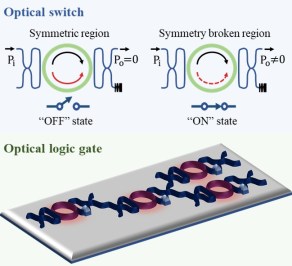
We present optical switch and photonic logic gates utilizing phase changes of optical fields arising from Kerr interactions.
Laser & Photonics Review, e01500 (2025).

We present optical switch and photonic logic gates utilizing phase changes of optical fields arising from Kerr interactions.
Laser & Photonics Review, e01500 (2025).

Our paper on ultralow loss silicon nitride integrated photonics using room-temperature reactive sputtering has ranked within the top 10% of most-viewed papers published by Laser & Photonics Review in 2023. Laser & Photonics Review, 2300642 (2023) – arXiv:2301.10758.
.

Shuangyou is awarded a DFG grant on Low-Temperature Sputtered Silicon Nitride for Integrated Photonic Applications, together with Pascal. The project will fund a PhD position for 3 years, offering an outstanding opportunity to contribute to cutting-edge research at MPL.

We report a novel approach for on-chip optical switches based on the first experimental demonstration of spontaneous symmetry breaking in high-Q Si3N4 resonators. This can be used for the implementation of on-chip optical memories and optical gyroscopes.
Photonics Research 13, 360 (Editor’s pick!)

We investigate broadband dispersion engineering in microresonators by incorporating nanostructures along the sidewalls of ring resonators. This can be used for broadband frequency comb generation.
Photonics Research 13, 367

Our research group was very involved in the filming of “Tracing Light”. The film explores light in many facets between art and science. It will be shown in cinemas across Germany starting Jan 16th 2025.
Tracing Light Infos
Official Trailer

The new book “Optical Frequency Combs – Trends in Sources and Applications” has been published. It includes a chapter from our group on microresonator frequency combs.
https://doi.org/10.1201/9781003427605

Our new paper about linear and nonlinear coupling of light in twin-resonator systems with Kerr-nonlinearities has been published. This can lead to real-time dispersion engineering, and active light distribution in telecom systems.
Photonics Research 12, 2733

Our new paper about light distribution patterns in chains of microresonators has been published. This can be used to guide light through photonic circuits and for optical data processing.
Photonics Research 10, 2376 (Editor’s pick!)

We demonstrate a new method for Hz-level spectroscopy with a scanning diode laser. Instead of using a frequency comb, this method relies on adding modulation sidebands to the scanning diode laser and linking it on-the-fly to a reference cavity.
Advanced Photonics 6, 046003
SPIE News Article

Our group will be at Optica Advanced Photonics Congress in Québec, Canada from July 28th to August 1st and present our research projects in 9 talks.
Link to conference program

Our new PNAS paper presents the observation of controlled standing wave patterns that can be used for precise distance measurements with nm-accuracy. PNAS 121 (10) e2313981121, arxiv.

Our paper on ultralow loss silicon nitride integrated photonics using room-temperature reactive sputtering was published in Laser & Photonics Reviews. Our study demonstrates the lowest propagation losses achieved with a low temperature deposition method. It is CMOS compatible and can be used for hybrid integration with other photonic and electronic processes. Laser & Photonics Review, 2300642 (2023).

Our new paper titled “Geometry optimization for dark soliton combs in thin multimode silicon nitride microresonators” was published in Optics Express, which provides insights into engineering a Si3N4 structure for optimal effective nonlinearity with a compact footprint. We experimentally demonstrate the low-noise dark pulses with a repetition rate of 25 GHz in a Si3N4 resonator. Read more: Optics Express 31, 41420-41427 (2023).

Our paper on quintic soliton paper has been selected as the cover article in laser & photonics review. Our study demonstrates the first observation of solitons induced by fifth-order dispersion. Read more: Laser Photonics Rev., 2300075 (2023).

Our new paper on four-field symmetry breakings in photonic dimers has been published in Physical Review Research. This work demonstrates multi-level symmetry breakings, switching and chaos. Read more: Phys. Rev. Res. 5,L042012 (2023).

Our group will be at CLEO Europe in Munich from June 26th to June 30th and present our research projects in 9 talks.
Link to conference program

Our new paper on quintic-dispersion microresonator solitons has been published in Laser & Photonics Review. Our study demonstrates the first observation of solitons induced by fifth-order dispersion. Read more: Laser Photonics Rev., 2300075 (2023).

Congratulations to Arghadeep Pal for winning the best poster award at the spring school-2023 organised by the Max Planck School of Photonics (MPSP). The poster describes Machine Learning assisted prediction of microresonator structure for desired dispersion profiles. Read more: Opt. Express 31, 8020-8028 (2023).

We have used machine learning algorithms to predict structures of microresonators from dispersion profiles. This work lays the foundation of application of machine learning in inverse design of microring resonators.
https://doi.org/10.1364/OE.479899 – arXiv

Our new paper on optical light plateaus in microresonators has been published. This work has been done in collaboration with Gian-Luca Oppo and Graeme Campbell at the University of Strathclyde in Glasgow. https://doi.org/10.1103/PhysRevA.106.043507 – arXiv

We will be presenting at the upcoming CLEO conference in San Jose, California (15-20 May):
Lewis Hill, “Nested spontaneous symmetry breaking” 17 May
Shuangyou Zhang, “Dark-Bright Soliton Frequency Combs” 18 May
Leonardo Del Bino, “All-optical Kerr Polarization Controller” 19 May

Our new paper on bound states of dark and bright solitons in microresonators has been published in PRL. This can be used to broaden frequency combs across different dispersion regimes.
➔ Physical Review Letters, 128, 033901
➔ Press Release

Together with colleagues from Switzerland, Germany and the UK we have demonstrated a polarization controller that is operated purely by light using the Kerr-effect.
➔ Nature Communications, 13, 398
➔ Press Release

Our work on Kerr-effect enhancement of the rotation sensitivity of microresonator gyroscopes has been published in Optica.
➔ Optica 8, 1219-1226
